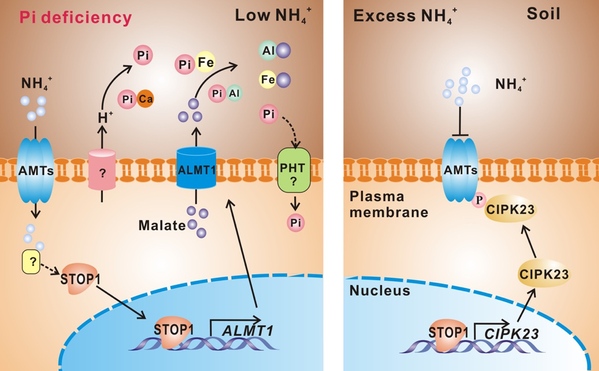Transcription factor STOP1 coordinates ammonium and phosphate nutrition
The research team led by Prof. ZHENG Shao-Jian from the Zhejiang University College of Life Sciencespublished a research article entitled “A Transcription Factor STOP1-Centered Pathway Coordinates Ammonium and Phosphate Acquisition in Arabidopsis” in the journal Molecular Plant on June 30, 2021 (doi: /10.1016/j.molp.2021.06.024). This study uncovers the molecular bases of low phosphorus-induced secretion of organic acids and the mechanisms for the coordination of phosphorous and nitrogen nutrition in plants, thus providing new insights into the utilization of insoluble phosphorus in soil by breeding new nutrient-efficient varieties and developing targeted fertilization techniques.
Phosphorus is an essential macronutrient for crop growth and development, but the efficacy of phosphorus in soil is often very low. Accordingly, agricultural production requires a substantial quantity of inorganic phosphate (Pi) fertilizers. However, only 20-30% of Pi is taken up by in season crops, and the rest tends to become insoluble or lost. Therefore, improvement of Pi acquisition efficiency from soil by crops is of immense significance to ensure the sustainable development of agriculture.
Plants have developed adaptive strategies to enhance Pi acquisition in response to Pi deficiency. These strategies include induced expression of Pi transporter genes, changed root system architecture and enhanced secretion of phosphatases and organic acids. A recent study showed that the transcription factor STOP1 (SENSITIVE TO PROTON RHIZOTOXICITY 1) regulates citrate and malate secretion by directly activating the expression of its targets, MATE (MULTIDRUG AND TOXIC COMPUND EXTRUSION) and ALMT1 (ALUMINUM-ACTIVATED MALATE TRANSPORTER-1) efflux transporters. Low Pi enhances STOP1-ALMT1 regulated malate extrusion, which mediates photo-Fenton reaction and a canonical Fenton reaction, leading to the production of hydroxyl radicals that inhibit the growth of primary roots. However, the upstream signaling events of Pi deficiency-induced organic acids and the mechanisms for the enhancement of STOP1 protein accumulation remain largely elusive.

ZHENG Shao-Jian et al. discovered that ammonium is a novel initiator that can stimulate the accumulation of STOP1 in the nucleus of Arabidopsis root cells due to Pi deficiency. Their study showed that Pi deficiency promotes ammonium uptake mediated by AMT1 transporters, and rapid acidification of the root surface. Rhizosphere acidification-triggered STOP1 accumulation activates excretion of organic acids, which helps solubilize Pi from insoluble iron or calcium phosphates. Ammonium uptake by AMT1 transporters is down-regulated by CIPK23 protein kinase whose expression is directly modulated by STOP1 when ammonium reaches toxic levels. A STOP1-centered regulatory network is thus identified that links external ammonium with efficient Pi acquisition from insoluble phosphate sources.
“These findings provide a framework towards strategies to improve crop production by enhancing the utilization of non-bioavailable nutrients in soil,” said Zheng.